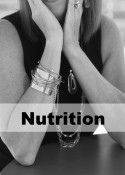Wellness Tips, Healthy Recipes, Inspirations, Lifestyle, Nutrition + More
Learn About Collagen with these Amazing Facts

Learn About Collagen with these Amazing Facts
Your body has so many cells, parts, and systems. And many of them are held together with collagen. The most abundant protein in your body is all about connection and strength. That’s because collagen’s adhesive qualities are only matched by its ability to provide structure and strength.
This impressive protein deserves a lot of discussion. From collagen and skin to its production process, what follows are all the facts you need to know about collagen. Thirty to be exact. (It’s so important, a list of 10 or even 25 just wouldn’t do.)
- You’re made of a lot of protein. And you already know collagen is the most common. But about 30 percent of your body’s proteins are one type of collagen or another. (Patience! You’ll read all about the different types in number 19.)
- Collagen isn’t just important for humans. Your animal friends rely on it just as much. That makes collagen the top dog of proteins in the animal kingdom.
- The roots of the word “collagen” go back to the Greek word kólla, which means glue. And now all that talk about connections and adhesive effects starts to make a little bit more sense
- Saying collagen is found throughout your body is kind of an understatement. It’s a structural element of bones, muscles, tendon, and ligaments. Collagen and skin are always talked about together, because it’s a major component of your largest organ. But that’s just the start. Collagen is also found in:
- blood vessels
- the cornea of your eye
- teeth
- cartilage
- discs between your vertebrae
- the digestive tract
- The fibrous nature and strength of collagen make it an ideal protective casing for your kidneys and other organs.
- Let’s take collagen’s prevalence one step further. It also helps connect cells all over your body to each other. So, it’s large scale—bones, ligaments, and organs—all the way down to the cellular level.
- Why is this such an important structural protein in animals? First, collagen is thermally stable. Second, it has a lot of mechanical strength. Third—and maybe most surprising—it can interact with other biomolecules.
- Age is about the only thing that can stop collagen from being amazing. (There are a few other things you’ll learn about later, too.) The older you get, the less collagen you make. And what you do make is not as high-quality as the collagen of your youth. This impacts the appearance of skin, the maintenance of joint health, and much more.
- Not to scare you, but this process of collagen decline starts in your twenties or thirties. Sooner than you thought (and hoped), right?
How Collagen and Skin Are Linked
Collagen is important everywhere. But nowhere is this more evident than in your skin. Collagen is key to your skin’s appearance. And your skin produces a lot of collagen. So, they’re frequently talked about together.
This structural protein is so important that it makes up 75 percent of your skin’s dry weight. It also gives your skin strength and elasticity. It provides the stable structures upon which your beauty is built.
That’s why much of the skincare conversation is about collagen in one way or another. It’s probably second only to moisture when you talk about the science of skin health, structure, and care.
Collagen is most prevalent in the second layer of your skin—the dermis. Two types of collagen make up the structural elements and connect the middle layer of skin to the epidermis above and hypodermis below.
Since so much of your skin’s structure depends on collagen, it plays a big role in the appearance of fine lines and wrinkles. Adequate collagen production makes skin look smooth and firm. It makes skin appear youthful and vibrant.
Then it’s no wonder that your body’s ability to produce healthy amounts of high-quality collagen depends on your age. So look for ways to support healthy collagen production for the appearance of younger, firmer, smoother skin.
- When it comes down to it, proteins are just groups of amino acids. Collagen is no different. It features the triumvirate of glycine, proline, and hydroxyproline.
- The production of collagen starts with procollagen—the substance secreted by your cells. It goes through processing in two parts of your cell, the endoplasmic reticulum and Golgi body.
- This whole process doesn’t happen without vitamin C. So, add another important item to vitamins C’s to-do list.
- People used to think collagen was only the product of fibroblasts—common cells in the connective tissue. But a variety of different cell types make the protein because it can be stretched without tearing apart.
- The structure of a collagen protein is what gives it the unique strength your body needs. It’s a triple helix—three chains twisting around each other.
- There are 1,050 amino acids in each of the three chains that make up collagen. And they’re held together with hydrogens—the smallest atom.
- Glycine is amino acid that takes up the middle of the triple helix structure because it’s the only one that can fit.
- These long fibers don’t just exist as single protein ropes. Collagen can come together to form striated horizontal sheets.
- Type I collagen is stronger than steel—on a gram-for-gram basis. All of this extra science will help you understand why.

Collagen is in your skin and connective tissues, providing structure and strength all over your body. Its utility doesn’t end there. This pervasive protein is also used in two interesting, and very different ways. It’s a sausage casing and makes up the strings of musical instruments.
- Type I collagen? How many are there? Sixteen different types exist in your body. And they each have different structures and function. That’s a lot of variety for one protein.
- But most of your collagen is type I, II, III, or IV.
- In fact, about 90 percent of your collagen is type I. That’s the strongest type because it’s made of fibers densely packed together. It’s a structural component of bones, skin, tendons, cartilage, teeth, and other connective tissue. And can stretch—a lot, without breaking.
- Type II collagen isn’t quite as densely packed as type I. But it’s perfect for cushioning joints.
- Your muscles, organs, and arteries rely on type III. And type IV can help with filtering and is more of two-dimensional sheet that’s found in your skin.
- No matter what type of collagen, age is the ultimate enemy. But sugar and other refined carbs can also hamper your collagen’s repairing capabilities. Now you have one more reason to limit sugar in your diet.
- The sun is also an enemy of collagen. Ultraviolet radiation diminishes collagen production, so always practice safe sun exposure.
- Here’s reason 10,000 not to smoke: It’s bad for collagen production, too.
- It’s not all doom and gloom for your collagen production, though. Several widely available and easily obtained nutrients have been shown to help maintain healthy collagen production:
- Vitamin A (try sweet potatoes, spinach, carrots, and mangos)
- Vitamin C (found in citrus fruits, red pepper, broccoli, cauliflower, and tomato)
- Copper (you’ll find it in organ meats, shellfish, lentils, almonds, dark chocolate, asparagus, and black pepper)
- Anthocyanidins—the phytonutrient (plant pigment) the gives blueberries, blackberries, and raspberries their deep colors
- Stocking up on the amino acids is another way support your body’s ability to manufacture this important protein. Glycine can be found in many protein-rich foods, including pork, beef, and chicken. If you’re looking for proline, turn to egg whites, dairy, mushrooms, asparagus, and almost any food with protein. Eating amino acids won’t guarantee an uptick in collagen, but it’s worth a shot—and already part of a healthy diet.
- Bone broths are typically rich in collagen. That makes sense when you consider that they’re made by boiling animal bones. And, as you know, bones and the connective tissues that surround them have plenty of collagen. Gelatin is also basically just cooked collagen.
- A healthy, balanced diet is a great foundation to help your body keep cranking out the collagen.
In Conclusion, Collagen is Your Coolest Protein
Now you know at least 30 things about your most abundant, important protein—collagen. Even if that was a little bit of information overload, just remember these three things:
- Collagen glues you together.
- No matter which of the 16 forms it takes, collagen is strong and fibrous to support structures throughout your body.
- Living a healthy lifestyle is a great start to supporting healthy collagen production.
Don’t just hoard all this wonderful information about collagen.
Share it with your friends and family. Introduce them to all the things that make collagen such an integral part of the human experience, because it provides the glue to keep your body together.
Source and References
https://www.askthescientists.com








